#victorian british evangelicalism
Explore tagged Tumblr posts
Text
"In their account of the history of the British Evangelical Alliance, David Hillborn and Ian Randall insist that a desire for Evangelical unity was the primary motivation behind the creation of the organization, citing Essays on Christian Union (1845), among other texts, in support of their claim. However, while the outward expression of a desire for Evangelical unity in the cause of the Gospel permeates this collection of essays, lending credence to the claim of a positive rationale behind the creation of the Alliance, other, more negative, factors are also present, particularly concern about the rise of Roman Catholicism.
The struggle between the Tractarians and Evangelicals during and after the 1830s for control of the Church of England and the Maynooth controversy of 1844, in which the British government gave additional money to a Catholic seminary in Ireland, encouraged anti-Catholic prejudice. Many of the contributions to Essays on Christian Union suggest that anti-Catholicism was more important to the emergence of the Alliance than Randall and Hillborn are willing to admit. Like the identity of any other group, Evangelical identity was construed partly in terms of what they were not, and opposition to Catholicism was integral to their growing self-consciousness. In response to the perceived threat of Catholicism, a threat that one of the contributors to Essays on Christian Union, Ralph Wardlaw, equates with the antichrist, another contributor, Reverend J.A. James, urged:
《Our appeal, therefore, is made to all Evangelical Protestants --Is it not time to unite? Does not your situation require it? Strike hands, then, in a covenant of love and friendship, and form a holy league, aggressive and defensive, against a system which is aiming to destroy you utterly, that it may be left at liberty to pursue its unobstructed course through the world, the consummation of which would be reached in overthrowing Evangelical religion, and planting everywhere a baleful superstition in its place.》"
--Emma Mason and Mark Knight, Nineteenth Century Religion and Literature, Oxford: 2007.
3 notes
·
View notes
Text
The Sign of the Four: The Statement of the Case
CW for the end of this as it includes discussions of child murder and detailed discussions of capital punishment.
Turbans have never been particularly common in the United Kingdom; these days, they are most likely to be worn by West African women or those who are undergoing chemotherapy.
It was the norm for a married woman to be referred to as "Mrs. [husband's name]", especially on something like a dinner invite. Historically, in the English common law system the United States also uses, a woman's legal identity was subsumed by her husband on marriage, in something called coverture. In some cases, a woman who ran her own business could be treated as legally single (a femme sole) and so sue someone - or be sued. This practice was gradually abolished, but did fully end until the 1970s.
@myemuisemo has excellently covered the reasons why Mary would have been sent back to the UK.
As you were looking at a rather long trip to and from India, even with the Suez Canal open by 1878, long leave like this would have been commonplace.
The Andaman Islands are an archipelago SW of what is now Myanmar and was then called Burma. The indigenous Andamanese lived pretty much an isolated experience until the late 19th century when the British showed up. The locals were pretty hostile to outsiders; shipwrecked crews were often attacked and killed in the 1830s and 1840s, the place getting a reputation for cannibalism.
The British eventually managed to conquer the place and combine its administration with the Nicobar Islands. Most of the native population would be wiped out via outside disease and loss of territory; they now number around 500 people. The Indian government, who took over the area on independence, now legally protect the remaining tribespeople, restricting or banning access to much of the area.
Of particular note are the Sentinelese of North Sentinel Island, who have made abundantly clear that they do not want outside contact. This is probably due to the British in the late 1800s, who kidnapped some of them and took them to Port Blair. The adults died of disease and the children were returned with gifts... possibly of the deadly sort. Various attempts by the Indian government (who legally claimed the island in 1970 via dropping a marker off) and anthropologists to contact them have generally not gone well, with the islanders' response frequently being of the arrow-firing variety. Eventually, via this and NGO pressure, most people got the hint and the Indian government outright banned visits to the island.
In 2004, after the Asian tsunami that killed over 2,000 people in the archipelago, the Indian Coast Guard sent over a helicopter to check the inhabitants were OK. They made clear they were via - guess what - firing arrows at the helicopter. Most of the people killed were locals and tourists; the indigenous tribes knew "earthquake equals possible tsunami" and had headed for higher ground.
In 2006, an Indian crab harvesting boat drifted onto the island; both of the crew were killed and buried.
In 2018, an American evangelical missionary called John Allen Chau illegally went to the island, aiming to convert the locals to Christianity. He ended up as a Darwin Award winner and the Indians gave up attempts to recover his body.
The first British penal colony in the area was established in 1789 by the Bengalese but shut down in 1796 due to a high rate of disease and death. The second was set up in 1857 and remained in operation until 1947.
People poisoning children for the insurance money was a sadly rather common occurrence in the Victorian era to the point that people cracked jokes about it if a child was enrolled in a burial society i.e. where people paid in money to cover funeral expenses and to pay out on someone's death.
The most infamous of these was Mary Ann Cotton from Durham, who is believed to have murdered 21 people, including three of her four husbands and 11 of her 13 children so she could get the payouts. She was arrested in July 1872 and charged with the murder of her stepson, Charles Edward Cotton, who had been exhumed after his attending doctor kept bodily samples and found traces of arsenic. After a delay for her to give birth to her final child in prison and a row in London over the choice the Attorney General (legally responsible for the prosecution of poisoning cases) had made for the prosecuting counsel, she was convicted in March 1973 of the murder and sentenced to death, the jury coming back after just 90 minutes. The standard Victorian practice was for any further legal action to be dropped after a capital conviction, as hanging would come pretty quickly.
Cotton was hanged at Durham County Goal that same month. Instead of her neck being broken, she slowly strangled to death as the rope had been made too short, possibly deliberately.
Then again, the hangman was William Calcraft, who had started off flogging juvenille offenders at Newgate Prison. Calcraft hanged an estimated 450 people over a 45-year career and developed quite a reputation for incompetence or sadism (historians debate this) due to his use of short drops. On several occasions, he would have to go down into the pit and pull on the condemned person's legs to speed up their death. In a triple hanging in 1867 of three Fenian who had murdered a police officer, one died instantly but the other two didn't. Calcraft went down and finished one of them off to the horror of officiating priest Father Gadd, who refused to let him do the same to the third and held the man's hand for 45 minutes until it was over. There was also his very public 1856 botch that led to the pinioning of the condemned's legs to become standard practice.
Calcraft also engaged in the then-common and legal practice of selling off the rope and the condemned person's clothing to make extra money. The latter would got straight to Madame Tussaud's for the latest addition to the Chamber of Horrors. Eventually, he would be pensioned off in 1874 aged 73 after increasingly negative press comment.
The Martyrdom of Man was a secular "universal" history of the Western World, published in 1872.
29 notes
·
View notes
Text
Research on Victorian England
The Victorian era was the time period of Queen Victoria's rule in the history of the United Kingdom and the British Empire, lasting from 20 June 1837 until her passing on 22 January 1901. The era overlaps with the early Belle Époque era of Continental Europe in its latter half. It followed the Georgian period and came before the Edwardian period.
Higher moral standards were strongly advocated by nonconformist churches like the Methodists and the evangelical branch of the traditional Church of England. In terms of ideology, the Victorian era saw a pushback against the rationalism that characterised the Georgian century and a growing shift towards romanticism and even mysticism in terms of religion, social ideals, and the arts. A startling number of technological advancements occurred during this time period, which ultimately contributed to Britain's might and wealth. The development of the germ hypothesis of disease and groundbreaking epidemiological studies helped medicine advance as doctors began turning away from tradition and mysticism and toward a science-based approach.
During this time families were unable to stay together because men, women, and children all had to live separately. Children weren't taught to read and write, and the food wasn't particularly nice. Everyone was required to wear the same uniform, and anyone found in violation would face harsh punishment. But life was very different if you were wealthy.
0 notes
Link
Bare-Knuckle Matches
Boxing has a long and storied history, rising and falling in popularity through the ages due to a variety of influences. The first recorded fight took place in London in 1681, a bare-knuckle match that is the forerunner of modern boxing. But early boxing did not have the same rules as today’s sport. It was extremely violent, allowing moves that included eye-gouges, head butts, choking and more; some boxers died as a result. It was in this atmosphere that Elizabeth Wilkinson Stokes and other women in the U.K. took up the sport.
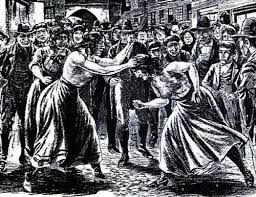
Female Boxers Enter the Ring
Although Stokes probably had fights that went undocumented, the first appearance of her name in print came in 1722, when she beat Hannah Hyfield in a 22-minute match. In the fashion of the day, men and women boxers promoted themselves by boasting about their abilities while challenging other fighters. Stokes called herself the “European Championess” and fought at various venues. While challenges to fight were printed in newspapers throughout England, the bouts themselves were not covered. However, it appears Stokes remained undefeated throughout her career.
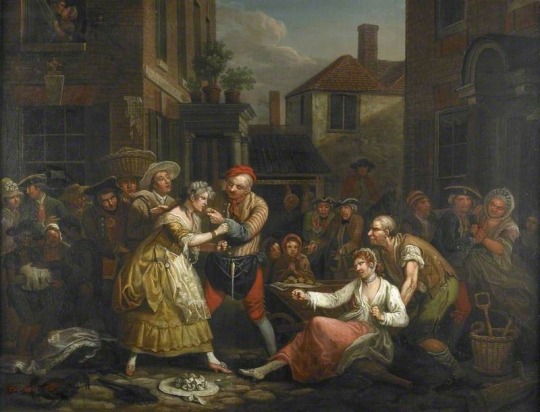
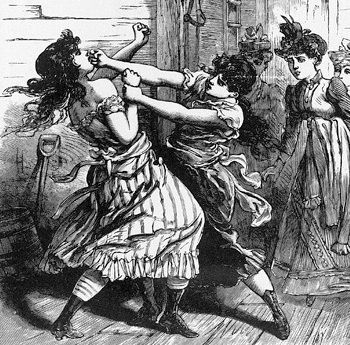
Women Boxers Fight in Pairs Matches
Boxing was a popular event in Great Britain, and although many did not favor the inclusion of women in the sport, others supported and even reveled in it. Elizabeth also fought in pairs matches with her husband, James Stokes. It was common during the early 18th century for female boxers to marry and fight alongside their husbands in couples’ events throughout the British Isles. Some of the contests during Elizabeth Stokes’ career include:
Stokes vs. Hanna Hyfield, 1722, in Hockley, England
Stokes vs. Mary Welch, 1726, at Stokes’ amphitheater in London
Elizabeth and James Stokes vs. Mary Welch of Ireland and future husband, Robert Baker, 1727, in London
Stokes vs. Ann Field, 1728, in Stoke Newington Parish, England
Elizabeth and James Stokes vs. Sarah and Thomas Barret of Ireland, 1728
Elizabeth and James Stokes vs. Mary Waller and Charles Wright, 1729
Weapons were also used in some of these early boxing matches before specific general rules were established. Although most of her bouts were boxing-only events, Stokes was also known for her skills in using a dagger and short sword.
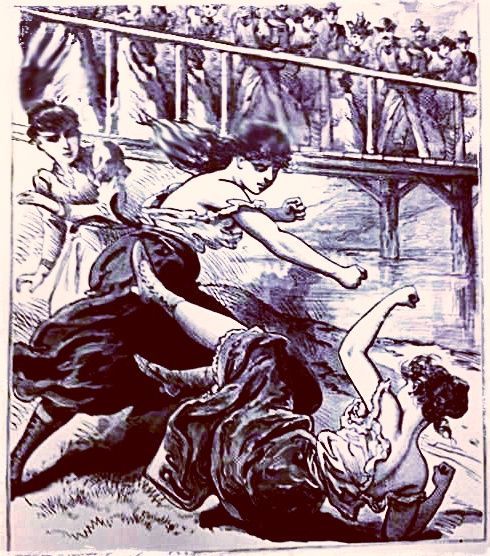

The Entertainment Aspect
Boxing was banned in other European countries until the early 19th century. While it grew in popularity elsewhere during the 1800s, female boxers fell out of favor in England, perhaps due to an evangelical Christianity movement that sent the sport underground. Female martial artists became a form of entertainment and were seen mainly in night clubs and shows. Yet there had always been some sensationalism in promoting women boxers. An advertisement for one of Stokes’ 1726 bouts said the participants would fight in petticoats that fell just below the knee, drawers, stockings and pumps.
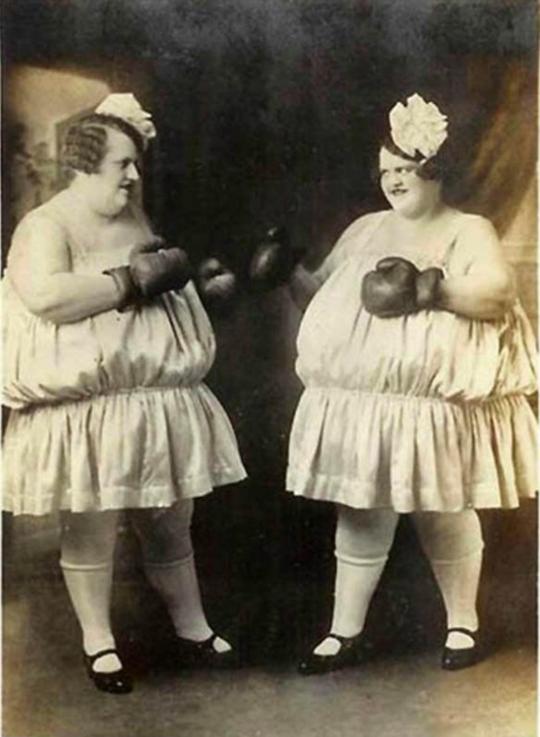

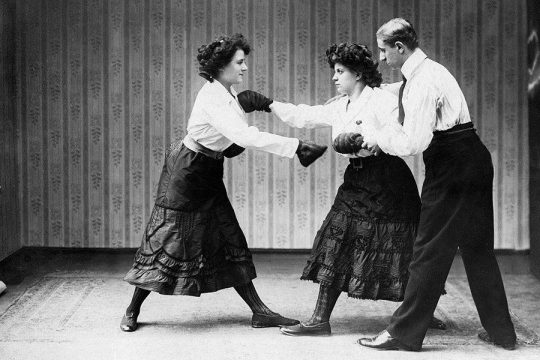
First World Championship Bout
Women’s boxing saw its first world championship bout in New York City in 1888, between Alice Leary and Hattie Leslie. The fight was ferocious, with both combatants receiving black eyes before Leslie won the match. The press belittled the women and the event. They caused such a commotion in the community that both women, plus Leslie’s husband and many others, were arrested and charged with “aiding and abetting a prizefight.” Yet female boxers continued to participate in the sport, and the 1904 Olympics, held in St. Louis, hosted an exhibition match.
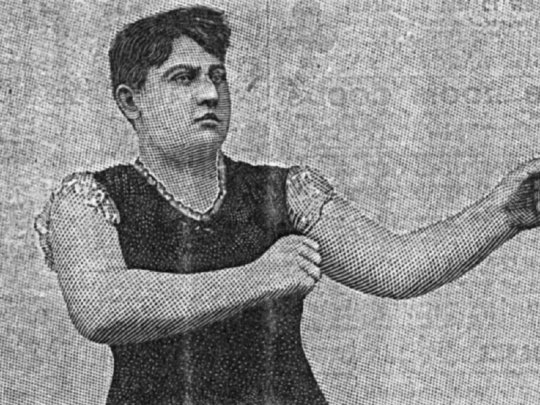
^Hattie Leslie
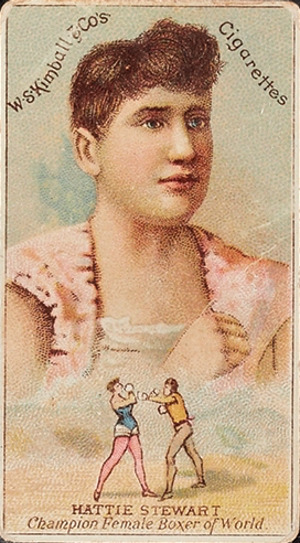
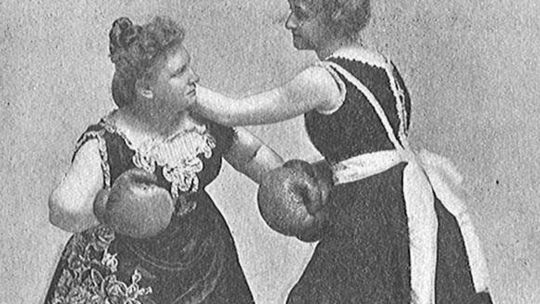
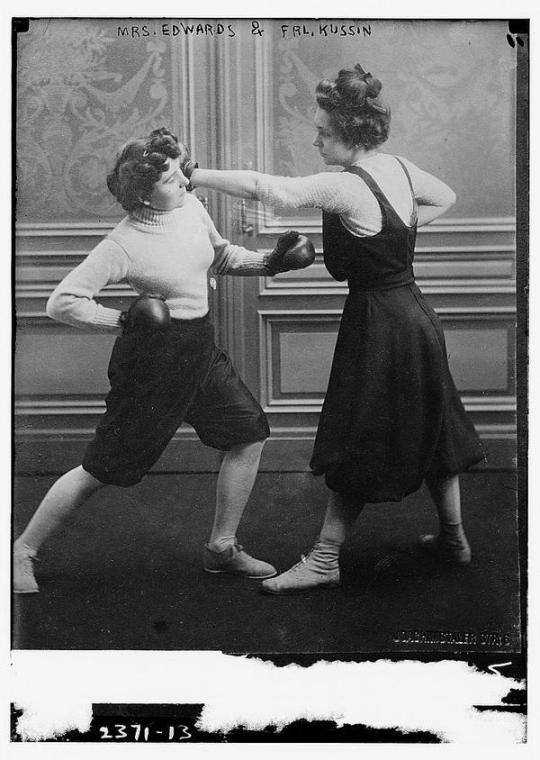
181 notes
·
View notes
Text
@siena-sevenwits
I don't believe we're mutuals, but can I recommend 'Under the Pendulum Sun' by Jeannette Ng? It's a Victorian Gothic novel about a universe where fairyland is discovered by the British Empire, who proceed to attempt to evangelize them. The main character's brother was the first missionary and disappeared and she travels to find him. It's not actually very religious, despite the premise, but it is creepy and deeply weird and one of my all time favorite books.
Spooky but not really all that terrifying book recs, O my mutuals with good taste in books? (that includes you, yes, you)
47 notes
·
View notes
Text
“Medieval” Media on TV checklist
It’s in the UK. They can name it whatever they want, but it’s supposed to be the UK. (And not anywhere specific either-- is it Cornwall, Yorkshire, Aberdeen? None of the above, and also all.) So of course, it was filmed in Hungary, Croatia, and 2 French castles. Also it’s always winter because in medieval-fantasy-old-times-England it was always winter, always cold and gray, and always muddy, because of Christianity. Or something.
Paganism stand-in religion that is free-love-feminism-horned-god-bambi-rainbow-divine-feminine-oh-goddess!-silver-ravenwolf-glitter-farts and gives you magic powers and probably Disney Princess animal-handling skills. Clergy are female except for the only relevant character who is male and also probably Merlin, wear woad and Ren faire face paint, and are free of dogma or structure despite somehow having once governed. Now pushed into the shadows by “new” Christianity stand-in that hunts followers of the “old” religion as heretics.
Grimdark and repressive Christianity stand-in that rules with a patriarchal iron first and has made everyone miserable. Inexplicably Protestantism-based and Evangelical-inspired. Despite claiming to be medieval, no mention of Mary, Saints, feast days, pilgrimage, mystery plays, music, rosaries or medals, icons or relics, or probably even confession-- if you get lucky somebody might mention a Nail of the Cross or have communion. None of the clergy really believe unless they’re zealots, or sympathetic-and-tragically-misguided (and probably self-hating lesbians or something), everyone else is there out of ambition. Unlike the “old” religion, this one has zero divine or magical power and if it appears to have, that will actually come from demons-- who are real, although “new” God isn’t. Exists just to police sex and personal expression, self-flagellate, and guilt trip characters vaguely about “sin” without providing any discussion of what level sin it is or how many Hail Mary’s must be said to expatiate it.
Witch hunting mania which combines Renaissance Inquisition with independent early modern Puritan witch finding-- somehow is both Church-sponsored and widespread. Goes after women who are too sexy and independent, women who can read, anyone who believes in birth control, and the protagonist’s mother. Also followers of “old” religion who are usually secretly the above. Anyone caught will be burned at the stake, because hanging isn’t flashy enough.
Corsets as outerwear. Because bodices and corsets are the same thing. And everyone wore their underwear over their clothes. Victorian tightlacing de rigeur to combat wandering wombs and female mobility. If a female character wears armor, it too, is probably a corset. The enlightened heroine finally abandons hers with a feminine gasp of relief-- and no lingering health issues from years of tightlacing-- and her titties stay up anyway because of the Wonderbra she has on underneath.
Priests look like Martin Luther or the Ku Klux Klan. Nuns-- if they exist-- are only there to get killed, possessed, or dominated by male clergy (and possibly squeeze in an ill-fated lesbian romance before doing any of the former). No one has ever heard of an abbess and if you bring the subject up they’ll burn you at the stake.
If there are any Romans, they are exclusively played by Irish or German actors, with crisp Shakespearean accents. If there’s a German, they’re Dutch or Russian. If the “English” characters are actually English, they must be Southerners doing a basic British accent; if not they’re played by Americans doing no accent at all.
Chrome plate armor was all the rage in 500 AD
Despite witnessing the magic of “the old religion” firsthand, and being born and raised in the “new” one, the protagonist is an atheist, and even if he should meet god in person will steadfastly refuse to believe in Him. Because he’s just too cool and enlightened for that.
The plague is ever present, and has no name, since no one needs to define which plague, because there has only ever been the one. Other than starvation or being killed by the Baddie’s henchmen or the Church, it’s the only way anyone has ever died (except for pregnant women, who all die in childbirth.) Symptoms include fever, coughing, concealer appearing inexplicably on the lips, and then a few dramatic final words.
Nobody brushes their teeth because it’s Olde Tymes (incorrect) and nobody takes baths because it’s Satanic (also incorrect) yet every character with the exception of somebody only credited as “Ancient One-Eyed Old Coot” is clean, has shiny hair, no BO, and mouthfuls of big white teeth. Also perfume was never invented in this world, and the only beverage is water, mostly drunk from the hands at random streams, which are never mucked up or disease-carrying.
All the peasants dress in throw blankets and the remnants of Water World’s costuming department in a color range going from “Black Death” to “Dun”, accessorized with warts and fresh mud. The nobles meanwhile, drowning in money and with trade access to China dress like they were sent to The Wall, with the exception of “sexy slut” character who wears magenta crushed velvet off-the-shoulder gowns, and the only gay guy in the movie, who has slashed sleeves in 1350 and is one gold chain away from a rap career.
During interviews the cast will all say how they “wouldn’t have survived in medieval times” with all the mud and disease and sexual repression and they would have probably been “burned at the stake” for reading or swearing. The women fulfill their contractual obligation to complain about their corsets, yet another reason they would have died in “medieval times”. Somebody mentions the plague.
The harvest will be burned a dozen times, all the livestock will be slaughtered, the populace will end up homeless and starving, (which will of course, only concern the protagonist, who must dutifully share a crust of plain bread with some toothless vagrant) but once The Baddie is slain peace will return to the land and the infrastructure will magically rebuild itself, miraculously re-planting fields and restocking larders. Also it’s Spring now.
#I was annoyed and had some time on my hands#game of thrones#cursed netflix#every 'medieval knight movie' ever#middle ages#medieval
103 notes
·
View notes
Note
If your fashion brand incorporates Bantu roots (iirc), will any of the pieces be traditional garments that I should look out for as an outsider? I try to stay away from cultural garments that would offend others if they saw me wearing them
That's a nice and considerate question🤍
I'm not one to get mad at people wearing other culture's textile or clothing. It's 2022 and our daily life is a melting pot of a bunch of different culture and this weird gatekeeping some people feel entitled to do reeks of insecurity. As a Black woman, I am genuinely embarrassed by Black women getting mad at non Black wearing Bantu knots or braids, when they themselves are literally wearing non Black women's hair on their scalp... At least, the non-White people doing these Black hairstyles are doing them with their own hair....🥴
I am currently obsessed with Kuba textile that originates from Congo. It's interesting that wax is hailed as a typical African textile when it's actually an import from European textile manufacturers lol (to give you an idea, the biggest wax manufacturer is Vlisco, which is a DUTCH textile company lol) So it's once again super funny to see some Black people getting butthurt defensive about non Blacks using or wearing it. So yes, wax eventually got reappropriated by Africans who made it a whole cultural symbol, exactly like the sailor suit, which is originally a British Empire uniform, got appropriated by Japan and eventually became THE symbol of the Japanese schoolgirl.
Here's a secret though : I always disliked wax because I'm not into colors like that lol I am MUCH MORE into Kuba textile that originates from my country of origin, Congo. I am fascinated with the shapes, the change of scale/"rhythm" of the composition. They are also much more toned down in term pf color (it's made of raffia so it's naturally brown and they use a natural dye(?) for the black or red color

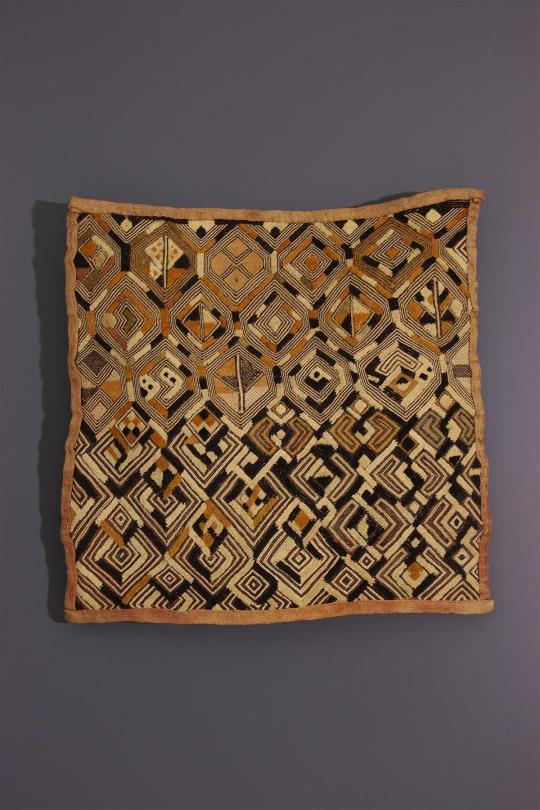
Since I have a fondness for illustration I will create original surface pattern for the textile the clothes will be made of. I willl literally draw them from scratch. Just because I am making modesty clothing doesn't it should look boring or like a cosplay of the regency era lol I already stated how Eurocentric the tradfem aesthetic was (99% of tradfem -who aren't even White themselves- I know are fancy'ing the Jane Austeen book/Victorian era aesthetic). I want to create a collection for creative and dreamy Christian women living in the 21st century - not cosplaying living in the 1800s. Not all of us are spending all daydreaming about our rude lover while wandering in an English garden : we work, we travel, our existence isn't relying on a male attention. We are real human being - not book characters. It's when I realized how bad I was struggling to find dresses in winter that I decided to make a brand aiming to fix this issue. Thanks to this poll, I realized that many other Christian women struggled to find clothes they felt comfortable with.
Btw, IDK if that's you who asked me the question in the poll but someone asked be if my collection was only for Christians and not Catholics and I want to make clear that despite not being Catholic (nor Protestant - I'm non-denominational lol) : my brand focuses FIRST AND FOREMOST to Christian women -from ANY denomination- seeking to wear clothes they feel comfortable with. Tbh, I think Catholics women are much more consistent than the Christian ones when it comes to modesty. Like, more Catholics seem to agree that women should be veiled at the assembly, not wear make up, dress modestly, etc. than the average Evangelical women who for the most part is more "liberal"/"GoD dOeS'nt cAre aBout ApPeAreaNce" type (which is untrue since the Bible has very precise prescriptions about our physical appearance LOL). So yeah, I respect Catholic women a lot<3
ps/ for those interested, my mailing list for my upcoming collection is up :) I will soon start updating my insta page (I already have a whole month scheduled lol) so subscribe to get updates and news :)
3 notes
·
View notes
Text
“Girls’ schools promoted an intense female peer culture which contrasted with the disciplines of moralistic home environments. Evidence from the accounts of girls attending the myriad female seminaries and girls’ boarding schools throughout the Northeast suggests that their academic programs were relatively gentle, and that their peer culture was powerful and often fun. Despite the best efforts of outnumbered teachers, relations with friends tended to overshadow lessons learned. Overwhelmingly when girls wrote home to their parents, they described the girls they had met, and the antics they had shared; in diaries they noted the romantic intimacies they had formed, with academic work generating only occasional mention.
Girls’ peer life at school was high-spirited, collective, and ritualized all at once. Teachers themselves often participated. At Miss Porter’s in Farmington, Connecticut, in 1860, teachers organized a costume party, suggested characters for everyone, and helped sew costumes—perhaps in part a sewing lesson. (For Lily Dana, suggestions included an elf, Mischief, or a witch.) At a Prospect Hill School party in 1882, townspeople came, the girls wore flowers and white dresses, and Margaret Tileston reported that she had done the quadrille with Miss Clarke and the gallop with Miss Tuxbury—concluding that she had had ‘‘a very nice time.’’
Girls remembering their days at convent schools report similar good times. Julia Sloane Spalding recalled elegiacally her years at Nazareth Academy, a school run by the Sisters of Charity in Louisville, Kentucky, in the 1850s. ‘‘The sisters allowed us to romp and play, dance and sing as we pleased and our stage performances were amusing, if they had no greater merit. Musical soirees, concerts, serenades and minstrelsy kept our spirits attuned to gladness. Varied by picnics, lawn parties, hayrides, phantom parties, nutting parties in summer and candy pullings and fancy balls with Nazareth’s colored band to fiddle.’’
Exclaimed Spalding, ‘‘O what fun!’’ in fond reflection on the good times among the sisters who served ‘‘good substantial sandwiches, cakes and fruit’’ from ‘‘great big baskets.’’ She concluded, ‘‘and so, the spice of life conduced to our health and happiness.’’ Mary Anne Murphy arrived at Nazareth Academy with her sister in 1859 during a quadrille, the slave musicians calling out the figures. She and her sister stood in ‘‘wonderment that such fun was tolerated in a convent.’’ Whatever the nostalgia of middle age, certainly these reflections suggest that elite Catholic and Protestant girls’ academies left some of their richest memories in collective fun.
If teachers sponsored some activities, they implicitly sanctioned many more. Wilfrida Hogan attended the Sisters of St. Joseph convent school in St. Paul in the 1870s and remembers fondly her class, which was known for its lively irreverence: ‘‘Each girl seemed to view the other as to who could play the biggest pranks, or have the most fun.’’
Ellen Emerson overflowed with delight in a letter to her mother (significantly, not her father) while at Miss Sedgwick’s School in Lenox, Massachusetts: ‘‘Every night we do things which it seems to me I can never remember without laughing if I should live to be a hundred. The most absurd concerts, ludicrous charades, peculiar battles etc. etc. Then the wildest frolics, the loudest shrieks, the most boisterous rolling and tumbling that eye ever saw, ear ever heard or heart ever imagined. I consider myself greatly privileged that every night I can see and join such delightful romps.’’
When teachers were around, the pranks were more likely to occur upstairs in student bedrooms. Lily Dana and friends joined together to victimize two other girls by putting crumbs in their bed, and cutting off candle wicks. Another evening Dana noted that she ‘‘Had some fun throwing pillows and nightgowns,’’ and though Miss Porter caught her, it did not seem to dampen much her spirits. Teachers at girls’ schools were occasion- ally disciplinarians, clearly.
One teacher told Lily Dana that ‘‘she supposed my mother let me do everything,’’ and the sisters at St. Mary’s Academy in South Bend, Indiana, turned the piano to the wall in order to keep girls from waltzing with each other. Yet students often emerged victorious; at St. Mary’s they played combs for dance music instead. (One participant reported that ‘‘the Sisters had to give up, for they knew not what to do.’’) The ideology of nurture combined with the shared exuberance of age mates overpowered much teacherly remonstrance.
It is sometimes hard to read such tales of schoolgirl exuberance without wondering whether the inmates had taken over the asylum, however, so a corrective is in order. One such account which requires a second look is the spirited account of Agnes Repplier, In Our Convent Days (1906), about her time in the late 1860s at a Pennsylvania school run by the Sisters of the Sacred Heart. Repplier writes of the pranks and passions of her band of seven partners in crime, in an ebulliant account designed to appeal to a readership newly attracted to childhood naughtiness in revolt against Victorian propriety. It is clear in retrospect, though, that she must have concealed or minimized an- other side to her experiences. For the denouement of her story is her expulsion and removal from a school she adored.
Peer cultures could also be cruel and hurtful beyond the control of evangelical teachers, as the practices of hazing in British public schools testify. Some of the most painful memories of inclusion and exclusion in girls’ schools centered around that most primal of media, the sharing of food. Food boxes, customarily sent from home, were the occasion for impromptu parties, a demonstration of wealth and taste, or an opportunity to play favorites.
The elation which greeted such arrivals might well prove a commentary on the regular fare at boarding schools, which sometimes undoubtedly was very poor. (The advice giver Mary Virginia Terhune’s critique of girls’ boarding schools included the accusation that they fed their students from a ‘‘common vat’’ which supplied breakfast, dinner, and supper all together, a practice partially confirmed by one account of eating the same stew at least twice a day at an Ursuline academy in San Antonio in the 1890s.)
At any rate, the arrival of food from home occasioned select gatherings and provided opportunities for discrimination among friends. When one friend’s mother brought good things to eat, Josie Tilton noted that ‘‘we’’ had a feast tonight, explaining for the future who she would always mean when she said ‘‘we’’—‘‘Lizzie, Emma, May and I’’— the groupness secured by inclusion in this select group of diners.
Lily Dana suspected a friend of being miserly and so snuck into her room to inspect. ‘‘There was a box which had been filled with cake, part of a pie and several other things filling her trunk nearly half full. . . . If I had a box sent to me I think I should give my friend more than ‘five or six cookies.’’’ If girls could feel short-changed by each other, relations with parents could also strain over the sending of food boxes, which represented extremely conspicuous con- sumption for girls attempting to ‘‘belong.’’
In an unusually direct letter home in the 1840s, Maria Nellis passed on to her parents her unmediated hurt and sense of disadvantage in the competition for food—and the status that came with it. Elizabeth got her box yesterday and was favoured with six times more things than I was. Her box was so large and heavy the master found it his match to carry it upstairs. She has 4 kinds of cake, nuts, apples, candy, clothing and every thing else, but after all, Dear Poppy, I am not jealous. . . . When you sent that box you did not send half what I asked. I was very disappointed. You said it would be eatables, but it wasn’t. You sent only a few apples, one cake and some clothes. Why didn’t you send me some nuts? I haven’t had a nut yet this winter, and indeed I expected nuts above all things. E. Fox had a box worth speaking of. Now that shows that you don’t care enough for me to even send me a few nuts.
Intermittently, Nellis regained control, but her grievance was palpable. Finally at the end, she acknowledged to her parents that she might be hurting their feelings, reassured them that she loved them all with ‘‘a deep and fervent love,’’ and promised better behavior in the future. Clearly at stake for her was both status in the school world and a primitive sense of deprivation in her own family.
As the correspondence suggests, the emotional atmosphere in girls’ boarding schools was not only intense but more expressive and enacted than that within moralistic, Victorian households. Within private, female, boarding academies, duty-bound Victorian daughters learned languages of sentiment, desire, and emotional excess censored from other parts of their lives. The elaborate conventions accompanying the expression and affirmation of affection among boarding-school girls, sometimes involving teachers as well, was indeed a separate ‘‘female world of love and ritual,’’ as Carroll Smith-Rosenberg affirmed in a classic article about nineteenth-century women’s culture.
In recent years, Smith-Rosenberg’s ‘‘Female World of Love and Ritual’’ has been attacked for its overgeneralizing characterization of an exclusively female emotional sphere in the nineteenth century, but her strongest evidence confirms the significance, the power, and the longevity of girls’ boarding school friendships, which were enacted through elaborate rituals in a range of schools.
The rituals of boarding school life centered around the making and breaking of special friendships, known variously as ‘‘affinities,’’ ‘‘specials,’’ or ‘‘darlings’’ and increasingly as either ‘‘smashes’’ or ‘‘crushes.’’ One way of expressing interest was to ‘‘filipine’’ with someone, to leave her a surprise gift outside her door. (When Lily Dana was caught, she needed to give her gift, a large apple, outright.) Such relationships played out in diaries, letters, and the poetry of autograph books. Girls expected to pair up for many school activities and entertained a variety of ‘‘dates’’ with different girls for walking, going to church, and sleeping.
Sally Dana wrote home to her mother explaining that she was following her father’s advice not to form special friendships too soon, and so had ‘‘slept in eight different beds.’’ During these private moments, girls would share secrets about their own likes and dislikes, each other, their teachers, families, and their school lives. The intricacy of such social calendars opened ample opportunities for misunderstanding and frayed feelings.
These peer relationships characterized elite female seminaries in the North- east, but they also appeared in a range of schools, including the African American Scotia Seminary, founded by the American Missionary Association in Concord, North Carolina, following the Civil War. Scotia had northern roots, which may have influenced its student culture. Glenda Gilmore tells us it was modeled on Mount Holyoke, and was ‘‘calculated to give students the knowledge, social consciousness, and sensibilities of New England ladies, with a strong dose of Boston egalitarianism sprinkled in.’’
Roberta Fitzgerald went to Scotia in the early twentieth century and kept a composition book, likely in 1902, which was filled with the talismans of schoolgirl crushes. A note inside addressed to ‘‘Dear Roberta’’ asked, ‘‘Will you please exchang rings with me today and you may ware mine again,’’ and Roberta herself wrote a sad poem to a friend ‘‘Lu’’ who had thrown her over.
And so you see as I am deemed
Most silently to wait
I cannot but be womanlike
And meekly await my fate.
Ah! sweet it is to love a girl
But truly oh! how bitter
To love a girl with all your heart
And then to hear ‘‘Cant get her.’’
And Lulu dear as I must here
Relinquish with a moan
May your joys be as deep as the ocean
And your sorrow as light as its foam.
On the back of the notebook, which also contained class assignments, was a confidence exchanged with a seatmate. ‘‘I was teasing Bess Hoover about you and she told me she loved you dearly.’’
For those much in demand, this charged atmosphere of flirtation and intimacy in the North and South represented an exhilarating round of fun and sport. For those less secure, diaries and letters presented an obvious outlet for the anguish of the neglected. Agnes Hamilton, a member of a Fort Wayne clan which sent several daughters to boarding school on their way to prominent careers in progressive America, experienced some of both. Sometimes she basked in the glow of family reputation; often she worried over her own inability to keep up with her illustrious cousins. Her unusually detailed accounts document an entire school culture rather than just an individual emotional life.
Hamilton’s first impressions of school social life at Miss Porter’s School were favorable, but even these revealed insecurities to come. In an entry from November 1886, when she was seventeen, Hamilton noted that ‘‘Farmington is just as perfect as they all said it would be, the girls, Miss Porter, and all.’’ Her reservation had to do with her own imperfections: ‘‘But I don’t think I am the right sort of a Farmington girl.’’ Even so, Agnes was in demand, describing a flurry of close attentions from numerous girls. A week later, in her cousin’s absence, she received displaced attentions:
Yesterday Mannie was very nice to me. I suppose she thinks I am lonely without Alice. We walked past the fill around by the river to the graveyard. Then she came in and we talked for an hour. All evening we were together. This afternoon we walked together too for Tuesday is her day with Alice. We went down to the green house where Mannie gave me some lovely roses. I would give anything to know what she thinks of me. . . . Will I ever be able to talk and be jolly as other girls? Some girls are frightfully stupid and yet they can make themselves somewhat agreeable. I have struck up a sudden friendship with Lena Farnam. We were together Saturday afternoon and evening and Sunday I asked her to be my church girl in Alice’s place.
Agnes was still in a position to be picky, noting one drawback: Lena ‘‘seems very nice indeed but I wish she were not only fifteen.’’ Lena was far from the only prospect. Agnes noted another new friend: ‘‘I have seen a great deal lately of Edith Trowbridge too. When she overcomes her shyness she will be exceedingly nice.’’ Not surprisingly, with all the intensity of the socializing, Agnes mentioned with no comment that only three out of thirteen in the class were prepared for their lessons that Tuesday. In those early weeks, Agnes Hamilton’s enthusiasm for this exciting life of emotional intrigue was palpable. The next week (she seems to have written on Tuesdays), Agnes announced to her diary ‘‘the jolliest crush in school’’ involving one of her very own intimates of the week before.
‘‘I walked with Edith Trowbridge this afternoon, on purpose to have her tell me about Lena. I hinted and hinted in vain. I told her about every other crush in school but she never said a word about Lena’s, so at last I told her that I knew all about it but even then she would not say a word about the subject. I hope she will tell Lena so that she will speak to me about it next Saturday when we are driving.’’ The triangulation of such relationships increased the possibilities for intrigue. Agnes wearied a bit of the uncooperative Edith, though, observing that though ‘‘very nice . . . she did not get over her stiffness.’’
Agnes Hamilton seemed to be trying to do her schoolwork, but her roller- coaster social life intervened. One day when she was preparing for class, a friend came by to teach her a dance step, from which she was interrupted by the arrival of a buggy she had rented to take another friend for a ride, the same girl whose ‘‘jolly’’ crush had amused her the week before. (‘‘The more I see of her the better I like,’’ she now reported. ‘‘Her face is rather attractive at first and then it grows on one.’’) When she returned, she found another visitor who stayed till it was time for tea.
The result: ‘‘I have not looked at my Mental since Thursday.’’ By the end of the same day, yet a new ‘‘crush’’ had taken over when Agnes got word of someone’s interest in her, and Agnes wondered ‘‘if I have ever been as actively happy.’’ The frenzy had settled down a week later, when Agnes announced that she had all her walking days ‘‘just as I want them.’’ Each day of the week was assigned a different companion, with whom Agnes would exchange intimacies and gossip, using the rituals of girls’ school life to structure its emotional extravagance.
One must conclude that the intensity of the social life was seen to serve some purpose, for evidence suggests that it was allowed to flourish until the turn of the century. (Lily Dana noted that Miss Porter’s permission had been sought for at least one and probably more sleeping dates.) At that time, new sexualized interpretations of girls’ and women’s friendships brought a crackdown on such friendships. At the time, though, they appear to have received official sanction. In fact, one of the first of Ladies’ Home Journal ’s ‘‘Side Talks with Girls’’ took up the question of ‘‘School Girl Friendships.’’ The Journal endorsed such girlish relationships for their innocence and energy and their precious brevity, saluting ‘‘the giddy, gushing period’’ as one which ‘‘never comes to some and to most it soon passes.’’
In particular, it contrasted this girlish spontaneity with the superficiality of the jaded young lady. Its contrast of ‘‘young girls, lively, radiant, energetic, spirited, loving girls’’ with ‘‘young ladies who talk of their beaux, dresses and the surface shows of society’’ represented another version of a conventional warning against precociousness. Girls’ crushes on other girls were still perceived as innocent and healthy—and would be well after doctors first began to cast suspicion over such relationships in the 1880s and 1890s.”
- Jane H. Hunter, “Competitive Practices: Sentiment and Scholarship in Secondary Schools.” in How Young Ladies Became Girls: The Victorian Origins of American Girlhood
13 notes
·
View notes
Text
Nineteenth-Century Religion and Literature: an introduction (2007) by Mark Knight and Emma Mason is a recommendable read if you are interested in 19th century British literature and its contexts... with caveats.
The first half (chapters on Dissent, Unitarianism, and the Oxford movement are a very competent summary of trends and phenomenons that aren't easy to describe, and in that way I wholeheartedly recommend to anyone interested in understanding the religious and socio-religious controversies that underlie so much of Victorian Literature. It covers the different eras of dissent, the relationships between Enthusiasm, Presbiterianism, Methodism, Unitarianism, Christian Socialism, the high church/low church/broad church distinctions, the role of industrialization, colonialism and development of the natural sciences in theological debates... it is very complete.
The second half (chapters on Evangelicalism, Secularization, and Catholicism) is... not nearly as good. It is ironic/interesting that what would or should be the easiest part to write is the one the authors seem to have the most difficulty with.
Most of the chapter on Evangelicalism is dedicated To Dickens and Collins' portrayal of it in Bleak House and The Moonstone. I can understand including some perspective of how broad church people regarded Evangelicals, but making it the bulk of the chapter (and then ending with Eliot as a rejection of an Evangelical upbringing) is too biased and not particularly useful if you want to understand Evangelicalism itself and it's authors. I myself am not a sympathizer of Victorian British Evangelicalism by any means, and yet... the missed opportunity to talk about Jane Eyre and The Tenant of Wildfell Hall in depth is felt.
It's not that the chapters are devoid of interest; the discussion around secularization touching on A Christmas Carol is very interesting, and so is the discussion of the influence of Catholicism and sacramentality in decadent authors such as Oscar Wilde. But they do feel more like poorly stringed article topics than the sort of systematic explanation one expects from an Introduction.
10 notes
·
View notes
Note
Why do "British" politics have such a problem with terf, at least when compared to the states? It seems to be a strange development.
I honestly don’t know how much depth there is to the theory that it’s because of some hangover from Victorian standards in what’s proper, or whether it’s some religious thing.
For me, it’s because some people know it’s an easy subject to become an absolute grifter over. I cannot wait for Joan McAlpine to get kicked out the SNP and I hope it happens soon.
The ridiculous bit is that they often use extremely right wing evangelical talking points but they’re too fucking stupid to see it.
Just protect your trans friends, and speak out against bigots.
21 notes
·
View notes
Text
you may blame aphrodite;
the sequel to in a future time; is now underway thanks to a charitable donation made by @sunnydisposish!
After a mythical summer on the coast of Thessaly, Greece, brings Yuuri Katsuki into Victor's life, it's up to Victor to find a way to keep him. The Midas touch which allowed him to so swiftly sail through his research while a student is proving a burden now; even Yuuri sometimes seems to think there's nothing he can't turn into gold. A story about how two people who've put each other on a pedestal become mortal again, and in so doing, find the sort of love that the gods used to inscribe into the stars.
https://archiveofourown.org/works/19390903/chapters/46142590
see below the cut for some thoughts re: a neat quirk of Victor’s resume in this chapter.
So, when I started writing in a future time I knew I was going to make Yuuri a graduate of Oxford and Victor a graduate of Cambridge, with the idea being (at least for Victor) that his research is a bit ahead of the mainstream where lots of people consume narratives about art and history (typically famous national museums like the Louvre or the British Museum, for instance). Because the piece was for Born to Make Art History, I needed Victor to have a bit of an ax to grind about art history in general for all the references to work and as it turns out I got to graft my love/hate relationship with The British Museum and with a lot of the art collections of the Catholic church / Catholic cardinals onto him. Because these are some of my favorite pieces of art and my favorite museums but they’ve also rendered incredible damage onto the public, either by refusing to return artifacts or simply by being the product of either A) stodgy British Victorians being puritanical about sex or B) closeted Catholics being puritanical about sex in the public sphere and gay as fuck in the private sphere.
Enter the sequel. Like in a future time, I want you may blame aphrodite to have artifacts in each chapter. They won’t be poems because Victor isn’t a poet, but in this chapter he’s applying for jobs in the background because he knows he can’t stay with Yakov forever and he’s not getting very far. I decided to include his CV, which meant looking up some of the kinds of things he would’ve been getting up to at Cambridge, which brought me to this page: https://www.classics.cam.ac.uk/museum/things-to-do/things-to-do-1/lgbtq-tours
I quote:
The story of why we do not have a statue of a hermaphrodite in our collection
And as soon as I saw this I blinked because in chapter one of in a future time (Victor’s prologue) he goes on a rant about the exact piece of art this page is referencing -
“.... Maybe you get close with The Sleeping Hermaphroditus, until you realize that the first person to snatch it up after rediscovery was Cardinal Borghese, and if you think too long about that while you walk around the Villa to take in the rest of its collection, you’ll realize many of the highlights are romanticized rapes, and you’ll see no mention of the fact that Scipione was probably gay and that Pignatelli wasn’t his close friend ...”
Now, I haven’t attended Cambridge’s tour, so I have no idea why they have a story about why they don’t have a copy of the Sleeping Hermaphroditus. I've seen this piece, or its copies, everywhere except for the Hermitage, but I was first introduced to it at Villa Borghese, which is another institution I have a love/hate relationship with. I love it because the collection is legitimately gorgeous; you will find two Bernini masterpieces there along with a number of incredible Caravaggios, among other things. It’s a breathtaking place. But Villa Borghese was the first place where I actually began to experience sharp, sharp cognitive dissonance in regards to the art collections of the Catholic church. First and foremost, Cardinal Borghese was almost certainly gay. You may feel about this however you like, but for me, I feel 1) frustrated about the way the Catholic church has, for years, insisted on vows of celibacy from the clergy who have proven at all levels of the church ever since its inception that these vows are unattainable and often unenforced at the highest levels; 2) deeply upset because the Catholic church continues, to do this day, to do incredible harm to LGBTQ+ people and they’ve got a long, long legacy of gay-as-fuck cardinals that somehow gets totally glossed over in the process so the hypocrisy is truly astonishing. ANYWAY. Back to the Galleria Borghese. The two Bernini masterworks are of Daphne & Apollo and The Rape of Prosperine*, both stories of women being pursued by gods unwillingly (*or possibly willingly depending on your view of Persephone mythology which again, has had its variants totally messed with by early historians in a number of cases). And this was the place that two things struck me: 1) wow, this Cardinal sure was into a lot of weird sex stuff* 2) that the two Bernini pieces (some of my favorite works of art) were both about the bad experiences of women, which A) still persists, thousands of years later B) were beautifully and maybe arguably harmfully romanticized by this brilliant male sculptor. Once you see that you can’t unsee it. You’ll find it all over the Vatican Museums, too, even with the artfully-placed leaves placed as the pieces were uncovered, decorating ancient genitalia to protect everyone’s purity (I find this practice a little humorous since Adam & Eve were naked in the garden and therefore one could argue that the leaves are, themselves, markers of sin). I saw it in the houses and castles of nobles all over Europe, where paintings and statues loomed over people’s dining tables. I asterisked 'weird sex stuff’ because, at least in Renaissance art, a lot of the reuse of Greco-Roman mythology was meant to be allegorical, and because when you look on a piece of art today and you think about things like trans rights or these masterpeices that deify the rapes of women, you’re doing so with a modern lens from a modern context, and it’s highly unlikely the original authors or artists experienced anything like the same thoughts. And truth be told you won’t ever really get to know what those people were thinking at that time. But it does remind me of a friend of mine who once asked a group in Beijing what the weirdest food they’ve ever eaten was as an ice breaker while we spent time getting to know each other. They replied “things you think are weird we don’t think are weird” which remains in my mind as the most obvious demonstration of cultural norms that I’ve ever experienced.
Anyway, I grew up in the evangelical church listening to a lot of narratives about how bad sex is for everyone, especially women, but it seems to me that centuries of keeping it in the closet has done us all more harm than good and by reading a bit about how Victor feels about the Sleeping Hermaphroditus and lots of the other things he was writing about hinted at in the excerpts from Beloved you were, in fact, learning a little bit about me.
25 notes
·
View notes
Text
The Extremist #1
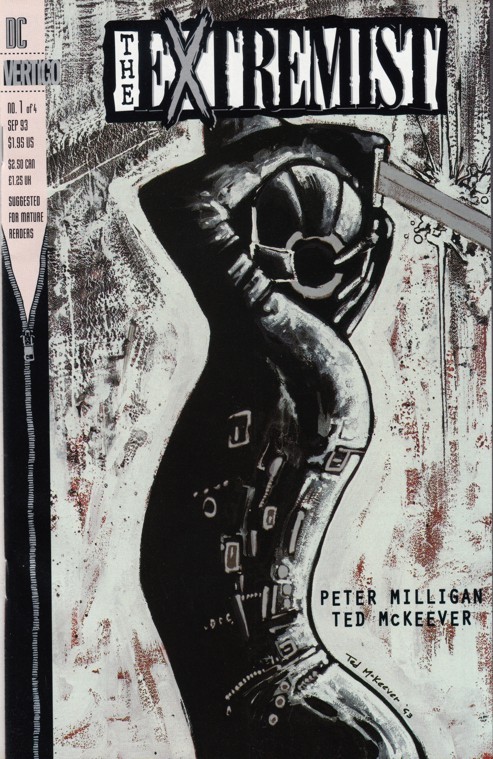
If you've ever really wondered how dumb I am and how much of it is an act, just watch how I completely miss the point of this series!
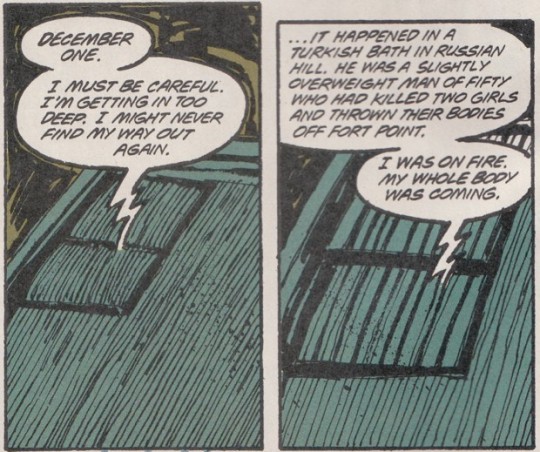
I wonder if Captain Kirk also felt like his entire body was coming every time he put on his captain's uniform?
The Extremist seems to be the one who punishes members of The Order who perpetrate terrible deeds. And somehow, the suit sexualizes the entire ordeal. So on December 1st, The Extremist punishes the slightly overweight man (who is actually obese because, I guess, Ted McKeever must be fat and he was all, "This guy, being slightly obese, should probably be drawn fatter than me!" That's just speculation. I mean, comic book writers are usually fat. The artists are usually hot fuckbots of raw sexuality) by stabbing him in his fat heart. Apparently people in The Order are allowed to engage in hedonistic pleasures that would be deemed immoral by members of the status quo. But even they have their limits on how far they allow their members to push the envelope. And Mr. Slightly Overweight killed two girls. So what do we know so far, kids? The Extremist is The Punisher in a gimp suit who constantly gets cum stains on the inside of the leather. The Order is a secret society where people engage in illicit sexual desires. And if you murder two girls, you'll be excommunicated from The Order (meaning you'll be killed). You might be able to get away with killing one girl but that's just speculation! The Extremist removes the suit to reveal a woman who can't stop making sexual analogies.
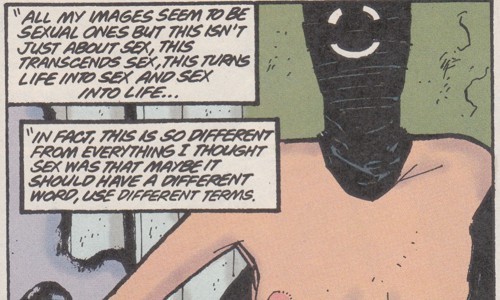
Maybe it's different than what you thought sex was because sex absolutely isn't stabbing a naked fat man in the heart. Okay, maybe that's a little bit like sex.
This lady walks away from the scene of the murder thinking, "I felt like The Extremist." So was she The Extremist and she was just worried that she was enjoying filling the role too much? Or is there some other Extremist she's emulating?! This would be so much easier if it were just a connect the dots puzzle. I hope you kids at home are following along. If you're not, you're pretty fucking stupid! This story isn't even complicated yet! It's just a commentary about how life is sex and sex is life and murder is sex but maybe not life and maybe not sex but somehow you'll still come in your pants! The Extremist mentions how she's doing this for Jack. She mentioned Jack earlier when she said something about him lying on the pavement outside a sushi restaurant while she said, "I dye my hair, Jack." So I guess the main story is about her and Jack. But it's going to be told in tiny snippets between her sex murders. Just like the real story in A Series of Unfortunate Events is the relationship between Lemony Snicket and Beatrice. I hope The Extremist gives us more of the real story per page than Lemony Snicket did. It was hard to remember all of the Beatrice details when he only mentioned her once like every hundred and twenty pages! Later that same night, The Extremist gets a call from Patrick (who reminds her of Jack) to go out and do some more Extremist work. She wanted to give it a rest because she's worried that the suit is taking control. So I guess it's a symbiote, right? But Patrick is all, "Come right over and don't take a shower! I want you to be all sex stanky in that thing!" The audio journal entry for that night contains the first words read in the story as a brown person's hand is seen playing one of her tapes but then rewinding it to begin the story on December 1st (as seen in the first scanned panel earlier). So that'll probably be important later! The Extremist meets with Patrick that night, mostly because he wants to fuck her. But she consents to see him because, as The Extremist, she's looking for Jack's murderer. She doesn't have a name yet so I can only refer to her as The Extremist. But that's a misnomer when she's out of the suit. Maybe we're not supposed to get to know her outside of the suit since this story is about The Extremist only and that is whoever is in the suit at the time.

She's also racist so I guess the name fits.
Beginning a racist statement with "I'm trying to be honest" doesn't mean you have to be forgiven for your racism. Maybe begin with "I'm trying to be not racist!" Oh, and then don't add a "but"! Patrick tells The Extremist a story about how Lords in Victorian England used to take in young East End girls living on the street. In return for giving them a home, they expected sexual favors. Patrick's ancestor stood up in the House of Lords to declare that it was the "inalienable right of every British Lord to find amusement among prepubescent working class girls." And then he says this:
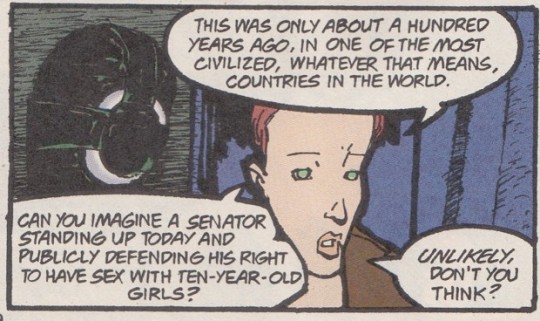
In 1993, that may have seemed unlikely. In 2019, we're one speech away from Trump making this exact declaration and the GOP and evangelical Christians falling right in line behind him.
Patrick's point is that his ancestor was making, for the time, a conservative defense against liberal views that poverty stricken children shouldn't be preyed upon. His point is that the "extreme" position varies across time and space due to changing cultural mores. I think the real point is that conservative ideas are always fighting against changes that help to protect those preyed upon by the rich and powerful. Which means conservative ideas and values are always fucking wrong. I said always! This comic book has a lot of tits and ass. But I don't think I've seen a penis yet. Not that I've been scouring every page with a magnifying glass to find one! That's slander! When he was alive, Jack was The Extremist's husband and also The Extremist. He was cheating on The Extremist outside of The Order and his being The Extremist which I guess makes his infidelity worse. It's fine if he fucks other people in The Order or even out of The Order as long as he's currently The Extremist. But doing it out of costume and out of The Order? That's a slap in his wife's face except whatever a slap in the face is sexually. I guess sometimes it's just a slap in the face! But more often, it's probably a slap on the fanny. Yes, I meant the British fanny! On December 9th, Patrick kills himself in a game of American Roulette. That's Russian Roulette except instead of one gun and bullets added as you take turns, players choose from a pile of guns with one of them loaded with six bullets. I don't know if Peter Milligan just made that up but it's a pretty good joke if he did. At the American Roulette game, The Extremist discovers Jack's killer. How she did it isn't as good as how Sherlock Holmes solves crimes. It's not even as good as how Matlock solves crimes. It's practically not even good as how Perry Mason solves crimes where he just hounds witnesses until there's just four minutes left in the hour and somebody confesses. She just notices somebody that doesn't look like they want to fuck her and just looks frightened instead and thinks, "A-ha! That's what Patrick said I should look for! Somebody who doesn't want to fuck me!" It's a good thing I don't know anybody who was murdered because I would think that every single person I ever met killed them. The Extremist heads over to this woman's house, the woman Jack was fucking, and kills her. But first she gets her to confess! That's important because you don't want to get caught in a loop where you keep killing new people because you're unsure if you killed the murderer. That would be like a cut-rate Memento where instead of memory loss, the protagonist just suffers from mild doubt. Judy (that's her name!) quits and moves to the suburbs. She leaves The Extremist suit and her audio tapes for somebody else to find (which somebody else does! On page one! The black homeless guy, I bet!). Nope, she goes back for the suit because she's super horny. The black guy probably finds the suit in a later issue. Or maybe he's working for the FBI. After she retrieves the suit, Patrick contacts her. He faked his own death and has become Pierre. I guess he's a vampire or something. Is that too fantastical for a story like this? Up until now, it's been super realistic with the whole sex club for people who need extra drama and sex in their lives. Also how it takes place in San Francisco! Patrick gives The Extremist a letter to read which is also an offer and/or her next mission. In the letter, Pierre confesses to killing Jack. The other woman was just a shill who wanted to be killed by The Extremist after being blamed for ruining The Extremist's marriage! The Extremist decides to kill Pierre because he ruined her life. The issue ends with her and Pierre about to do battle to the death. The next issue will concentrate on Jack's story, six months previous. The Extremist #1 Rating: C-. Picture Pages! Picture Pages! Time to get your Picture Pages! Time to get your strap-ons and Rohypnol! So, kids, what did you think of our first sordid tale of sordidity? Pretend this comic book was coming out this year and I didn't know Peter Milligan was writing it. Would I purchase the next issue? Probably not. I probably only bought the second issue in 1993 because there were so many titties in this one. Porn was a lot harder to come by in 1993! Other than the titties, I'm not sure I understand the point of this story yet. Is it about what people will do when they're pushed to the extreme? How far will a mousy wife who was shocked at doing sex on top go when she finds her husband has cheated on her and he's been murdered?! Or maybe it's about how we are the clothes we wear. Judy only loves to fuck and murder when she's in The Extremist's gimp suit. It's like that scene in Fire Walk With Me when Donna ties Laura's sweater around her waist and then starts fucking guys like crazy. Then Laura notices and is all, "Don't wear my clothes! Never wear my clothes, you dumb slut! Wait, who are you? Are you sure you're Donna? What happened to Lara?!" Sometimes I put a sock on my dick and then I'm all, "I'm a rock star! Look at me, mom!" I mean, I don't actually try to get my mom to look at me! That's just something I've heard people tend to say when they feel proud of themselves.
5 notes
·
View notes
Text










This book has quite a history of how it came to my hands from the United Kingdom. So, this article is going to tell you a little history. It all starts with a man named John Wilbur Chapman who was one of the most prominent clergymen, church leaders and revivalists of the later nineteenth and early twentieth centuries. More than sixty million people attended his evangelistic campaigns worldwide. He brought volumes and volumes of books with him to sell to the people who came to his crusades. When he ran out, he had the books reprinted in London and then Edinburgh. He dominated the evangelical landscape of America from 1906 to 1918. His campaigns in Canada were in conjunction with his world tours that helped his fame spread internationally. He is remembered only as a secondary figure in revivalism. Historians have treated Chapman mostly as one of Dwight L. Moody’s assistants and as a lesser colleague to some of Moody’s lieutenants. His work reinforced the understanding of the concepts and techniques of later nineteenth-century evangelism, and it has also revealed his contributions to the trajectory of revivalism. The study of Chapman's work also illuminates aspects of holiness, belief in a system of historical progression, as revealed in the Bible, that consisted of a series of stages in God's self-revelation and plan of salvation and social welfare during the Victorian and post-Victorian era.
The original purchaser of the book, Conrad Friedrich Boettger, received this book while attending a Canadian Evangelical Crusade in the United Kingdom somewhere between 1907- 19. He gave this book to his son, Heinrich Boettger, as a going away gift, since his son was moving to Canada. Ergo, he brought the book back to Canada with him.
Heinrich Boettger was born on the 9th of March 1875, in Germany, from his father, Conrad Friedrich Boettger, whom was 29 and his mother, Bertha Elise Florentine Jung, whom was 21 at the time of his birth.
Heinrich travelled to Canada in the early 1900’s, when he was in his early 30’s and met his wife in Ontario where they then started a family, where he had at least 1 son and 1 daughter with Emma Margaret Kalbfleisch; whom was a Canadian who was born in Ontario.
They moved to Saskatchewan. They lived a long happy evangelical German life in Saskatchewan until she passed away in 1935. Shortly after Heinrich turned 60 years old, he moved to Powell River to live out the rest of his senior years.
He died on the 20th of March 1953, in Powell River, British Columbia, Canada, at the age of 78, and was buried in Cranberry, Powell River, British Columbia, Canada. Heinrich went to a local evangelic Church in Powell River, BC.
Heinrich used his book at this church, but when it was starting to wear as he lost his dustjacket for the book, he covered the book with plain brown paper to keep the hardcover from wearing away as he used the book in his Church, regularly. To make sure he never lost his book, he put his name and address in the top left corner of the inside cover, with his last known address. Upon his death, his estate was auctioned off and some of his items were donated to: The Christian Book Room at 612 Fort Street, Victoria, BC. Where they not knowing what they had, put it up for sale for $0.95. When the store closed and the Elizabeth Fry Society took over its location, the books were then sent to other Christian Book stores throughout the Lower Mainland of BC and this book made its way, all the way out to Enderby where it was picked up by one of my children from the DO.U.NO.ME. Outreach. I was given it by this child who knew I liked old books; as a mother’s day gift. I ended up putting it into storage because shortly afterwards, as I moved to Langley BC and there is stayed in an environmentally and dust-controlled home where there were no pets and no smoking. Therefore, there have only been 2 gift purchasers and 2 owners of this book that is over 100 years old.
Please look at the pictures, they tell all, I am selling the book ASIS. You will enjoy just reading the book, the songs are wonderful. The index breaks the song into subjects, so as an example, if you are interested in a song about the life to come and the anticipation of heaven, it is in the songs from 907-927. There are several pages at the back of the book that give reference to the first line of every song if you can’t remember the actual name of the song. The cover still has a bit of a shine to it. I think he might have oiled the cover to keep the threads strong. This book also aligns itself with three other books that these two men created so that you can sing the same song from 4 different books.
Sacred Songs and Solos is a hymn collection compiled by Ira David Sankey, who partnered Dwight Lyman Moody in a series of evangelical crusades from 1870 until Moody's death in 1898. The collection first appeared in 1873 and has subsequently been published in many editions and formats, expanding to a final volume of 1200 pieces that appeared around 1907. This book was created and forever completed, one year before the death of Ira David Sankey.
The business, Morrison and Gibb Ltd of London and Edinburgh was founded in 1837 in Great Britain, and they were the printers who made and printed this book. They have their crest on the back of the hardcover book. This exact book content is being sold with newer publishing dates for $150 to $250 on the internet.
Although the publication was and is popularly known as Sankey and Moody's Songs, or The Sankey-Moody Hymnbook, many of the tunes and lyrics are by other authors, and the volume includes many standard church hymns. Around 200 of the tunes were written or arranged by Sankey.
Sacred Songs and Solos has been translated into many languages. Worldwide sales exceed 50 million.
Ira David Sankey, Methodist Lay Evangelist; born at Edinburgh, Lawrence County, Pa., USA, Aug. 28, 1840; died in Brooklyn Aug. 14, 1908. He entered business at New Castle, Pa., 1855-71, and was active as choir-leader, Sunday-school superintendent, and president of the Young Men's Christian Association; met D. L. Moody in 1870 at the international convention of that body at Indianapolis. He joined Moody in 1871 at Chicago and for years was associated with him in joint revival work in the United States and abroad, his part being singing solos, conducting the singing of the assembly, composing "Gospel hymns," and rendering assistance in the inquiry-meetings. In later years he also lectured.
In 1903 he lost his eyesight. He compiled Gospel Hymns (1875-95), and Sacred Songs and Solos (London, 1873, and often afterwards), of which over 50,000,000 copies were sold; translations have been made into many languages. He also composed many popular songs, of which are "There were ninety and nine," and "When the mists have rolled away." He is author of My Life and the Story of the Gospel Hymns and of Sacred Songs and Solos (Philadelphia, 1907).
PUBLISHER: Marshall Morgan and Scott DATE: no date BINDING: Hardcover SIZE: 5” x 7 ¼” appx NUMBER OF PAGES: 294 pages that are not paginated, no pages missing; no DUSTJACKET. Good condition for age, front hinge is still intact with nothing showing. Binding is still intact but starting to wear a little. You need to look at the pictures, I will give you as many as I can. Text appears clean and clear. The cover is without any bends there is a small scratch in the top center between the letters C and R. It even has a signature on the front cover.
Z3 copyright. My book is so old, it doesn’t have ISBN registration. The Zuse Z3 is German predecessor of the mark I-Monograph.
The characteristic of Z3 in copyright analog law is 3, meaning 3rd printing in London, after Ira David Sankey’s Death.
When you buy this book, you will be the third owner and have its entire history to hold on to and add to yours.
Always jo love
1 note
·
View note
Text
Gothic London (2): Bloomsbury

London's plush Bloomsbury area has a proud history of attracting radicals. Lenin, passers-by are informed, once lived on Tavistock Place.
Home-grown anti-establishment luminaries such as Lytton Strachey, John Maynard Keynes and their friends of the Bloomsbury Circle have their plaques on Gordon Square around the corner. Bertrand Russell is similarly honoured not far away.
But Bloomsbury's revolutionary heritage is perhaps best expressed, and certainly best preserved, in its Gothic Revival buildings.

Some may question my characterisation of that movement as "revolutionary". Its intellectual underpinnings, I admit, are profoundly reactionary. Exponents tended to be either right-wing traditionalists or socialist Romantics, and were united in a ridiculous view of pre-industrial England as a golden age.
In purely architectural terms, however, neo-Gothic and related nineteenth-century schools, such as Arts and Crafts and Art Nouveau, broke new ground.
Below are a few exemplars spotted during a wander through Bloomsbury.
Mary Ward Settlement, 42 Queen Square (1897)

The book that guided my steps, Christopher Winn's Victorian London, says it is "perhaps London's finest Arts and Crafts building".
The front glories in subtle asymmetry: note the positioning of the side entrances and the off-centre front door.
"Settlements" were facilities built by rich individuals to accommodate students free of charge in return for educating local indigents. This one was set up by Mary Ward, a best-selling novelist at the time, and financed by a newspaper baron.
Victorians, as everyone knows, were money-grubbing hypocrites who pretended that poverty could be alleviated by private means.
In these more enlightened times the Mary Ward Centre is a college that runs adult classes, at a price.
Church of Christ the King, Gordon Square (1853)

According to Winn, this is "one of the finest examples of Early English Gothic Revival architecture in London".
The church is big. It has the second-highest nave in England after Westminster Abbey. Nikolaus Pevsner, the ultimate authority on British buildings, said it had been designed "on a cathedral scale and in cathedral style".
But you'll notice something odd: it has no spire. When the architect, one Raphael Brandon, showed the drawings to his daughter and said he wanted to rival Westminster Abbey, the girl gave him a funny look.
"Dad, there is a tower and a spire on your church!" "Yes. Majestic isn't it?" "But Westminster Abbey doesn't have a tower." "Be a good girl and go to bed," Brandon smiled benevolently. "It's late."
He didn't sleep well that night. Doubt kept niggling at him. First thing next morning he took a cab. When he arrived at Parliament Square his face fell. He rushed back to his office, unfolded his drawings and ran an angry eraser along the top.
The building was paid for by a banker (remember what I said about the Victorians?) for his chosen religious cause, the Catholic Apostolic Church.
The theological coherence of this blend of Roman Catholicism and Scottish Presbyterianism eludes a dyed-in-the-wool French secularist. But the movement is still going strong, under a different name which also escapes me.
These good people were holding an "evangelical Mass" when my wife and I turned up. We were allowed to glimpse at the magnificent interior, which features ribbed vaults and a rose window.
Waterstones, Gower Street (1907)

This gem was built as an office block by Charles Fitzroy Doll (more about him below).
Winn doesn’t mention it, as strictly speaking it was not built in the Victorian era. Other sources say it is in the "Franco-Flemish Gothic style", but I haven't seen anything like it in Dunkirk or Lille.
I suspect this is pure English Gothic and the misnomer is another example of Brits, in their wariness of revolutions, passing off their trailblazing creations as foreign imports.
The building was the original location of celebrated bookstore Dillon's, before rival Waterstones took over the branch in 1999.
University College Hospital, Gower Street (1897-1906)

This was the last great work of Alfred Waterhouse, the guy responsible for the dazzlingl Natural History Museum in West London.
He gave the hospital an X shape, with towers soaring from each corner.
It was financed by a local furniture maker, another one of those Victorian hypocrites who affected concern for ordinary people by paying for their care.
University College Hospital looked after patients until the 1990s, when the National Health Service decided to relocate it next door. The old building got an expensive makeover and is now used by some biotech research outfit.
The new hospital complex glowers down on it, as if to say: "You may look cute, but I bet you don't do robotic surgery."
The Rising Sun, Tottenham Court Road (1897)

As you (briefly) leave the quiet elegance of Bloomsbury for the unkempt buzz of Tottenham Court Road, look out for the Gothic Art Nouveau façade of this pub.
The Rising Sun is a sight to behold, especially at dusk.
Russell Hotel, Russell Square (1898)

With the autumn light fading, we walked east towards Russell Square to admire Bloomsbury's most in-your-face erection.
The Russell Hotel (now called something else I forget) sprang from the fevered imagination of the aforementioned Charles Fitzroy Doll.
It claims to be a vision of a French Chateau but, again, Chambord and Chenonceau are models of conventional restraint in comparison.
Doll was a revolutionary's revolutionary. He was not so much ahead of his time as ahead of the future.
Twentieth-century officials didn't honour his legacy with a plaque: they did their level best to destroy it. After the Russell, Doll went on to build the Imperial hotel next door (pictured here on the left).

In the 1960s urban planners said: "This eyesore needs to be pulled down."
The Greater London Council ran a competition for a replacement. Someone came up with plans for the building on the right. The GLC said: "Perfect. That's exactly what we want."
The paying public is less enthusiastic. About half the reviewers on Tripadvisor give the Imperial Hotel average-to-terrible ratings.
0 notes
Text
You joke, but the left wing party in India deadass actually says this but uses AIT (which was made by German eugenicists and evangelicals to convert poor people and scheduled tribes to Christianity) to argue that any Indian lighter than black coffee is "not a real Indian and a white/foreign invader". And this is how you get people arguing that diaspora who have never set foot anywhere outside their gated community in Edison are more "Indian" than people who have lived in the country all their lives JUST because of their skin colour/caste.
They even try to say that Hindus aren't the "real Indians" because "Hinduism is the byproduct of white invasion and lead to the rise of Hitler" while also re-translating the works of Hindu scholars/poets to sound more Christian in order to displace people from their culture. Convent schooling was the norm for most Indians until the 1990s and were used to make Indians behave more in line with Victorian English norms.
Our textbooks for the longest time have also glorified our colonizers - especially the Mughals. We have whole chapters dedicated to Tipu Sultan and Akbar but at most a paragraph on indigenous rulers and empires. Entire genocides get either glossed over or reframed as "rebellions by the poor against the evil rich landlords." And even when we learn about the British, we learn that Gandhi and Nehru were responsible for independence when in reality they were simps for the Brits and the Soviet Union, while the real work was done by other lesser known fighters.
Pretty much every Indian born before 1991 hates their own country and culture and either simps for the British (greatest gen) the Soviets (boomers), or the Americans (Gen Xers and older Millennials)... and you can blame our "leftist" government for that.

It's legit, but everything English language I can find is either defending her or a banned subreddit a few of whom appear to have been keeping an archive of this kind of thing.
Oh and there's also the exceedingly racist people too, which should fit right in with her since she's one of them too.
Cept they hate each other because of their race
#in fact our country was almost ruled by white people TWICE#a big factor in why Modi won despite him at the time aligning with psychos#was because the alternative was a rich white christian dude with zero qualifications#the left in India are literally white ass kissers#in fact the left criminalized homosexuality and made anti transgender laws while the RIGHT legalized it!#the RIGHT elected a tribal woman as president while the left wanted a rich OC from an elite family!#and when the tribal woman won the left threw a screaming bitch fit and called her casteist and classist slurs#labels like left and right are utterly meaningless
303 notes
·
View notes
Text
I ask again that you not share the Tumblr with MVJ as he uses all knowledge of me against me or to imitate / try to be me rather than MVJ. I ask the same w/r/t MJ / Michael, as he resents me for various reasons to do with manipulation-leadership (such as telling him in '09 that I felt that I was going to be a doctor someday in order to hearten / give him morale when he was anguished over job-searching in the Great Recession). I do things like this because of a film called "Late Spring" a masterpiece by the Japanese director who inspired the Taiwanese auteur about whom I wrote my RU senior thesis and met Rebecca Hu who inspired me to work hard, get that Singapore job, meet Kate again in '07 in NYC, promise her in '08 I would struggle / fight / work for 3 years to become someone deserving of her (hand in marriage if not just friendship), which is also part of why I made that '08-09 deal with Dad that culminated in me going to MTTP in Madison, meeting Chi Hye, falling in love with this gold light in her eyes, believing in angels and mountains and "They shall mount up as eagles and not stub their toe" (Isaiah), meeting Josephine Park at 7-Step and everyone else, getting promoted to Head Developer in 6 months, then quitting b/c of a falling out I had on that night I called you after 6 months' radio silence. IDK if you want to hear this but I wanted to marry Josephine / "LitGirl." I thanked her for helping me. IDK if you care about this she flirted with me partly by showing armpit-stubble in the summer of 2010 and I understood this because I understand "Korean American literature." She might be the most beautiful perfect ideal "jeongdakhan" (kind of 'suitable,,' or, 'spec') woman I ever met. She went to Seoul National U. which is Korea's no.1 university and worked for an elite newspaper before taking some time off to write - she loves Emily Dickinson and, I believe, Park Wanseo, who wrote my favorite Korean short story "That Girl's House" about a promised couple in Japanese-occupied Korea who are separated by the girl's father's paranoia about Gop Dan's becoming a comfort woman and sold to be a farmer's bride in what becomes North Korea rather than marrying the "village prince" or aspiring scholar, who wants her to come away with him to Seoul... Josephine or "Jeongeun" (which kind of means perhaps "emotion-grace" or arguably "central grace" - Josephine means "love will increase" BTW and is the name of Jo from Little Women; the name she chose for herself) looks a bit like Lee Yowon the aspiring girl who gets plastic surgery in "Take Care of My Cat" and a bit like Seo Juhyun / Catherine Seo / Seohyun the youngest member of Girls Generation who was known for her probity, "Holy Seohyun" who was no. 2 in her HS before becoming the "maknae" or "final inner" / youngest and most beloved member of the nation's best-ever girl-group. FWIW, I used to write to Seohyun on Twitter as well but she never replied. On around the time of the sinking of the MV Sewol she wrote "we cried till our eyes dried" or so and used the word "huisaeng" to describe the victims which actually can mean "sacrifice." I wrote to Seohyun using a quote from Dante Alighieri about beauty and pure thoughts or pure minds since I read "New Life / Vita Nuova" and "Heaven / Paradiso" in KR. "Catherine" incidentally means "purity" as well. 2. On that night I first called you in 2011 I was out at a place with JEP and when I got back from our long phonecall she proceeded to get really drunk with foreigners I disliked from a hagwon I dislike throwing back soju and ultimately writing on the ladies' room floor throwing up. Danny Shin asked me to go in to the BR to comfort / talk with her so I did. I told her we should leave even before she got really drunk but she wouldn't obey me. KJ Park arrived and said "ireona" (get up bitch) and she did. I cursed in front of KJ Park since I felt I was being used as her crying-blankie and exploited to help her cope but never extricate from the situation. I later had a slight heart-attack when I found out they were having an affair even as JE flirted with other men and used them I see now as "honey-trap" and to spy on all the employees. I feel like this is the last time I will try to communicate open with you about why I am the way I am why I do what I do. Back in 2008 you told me to use more kindness but where does that go? It's good for little kids. Anyway before my heart-attack on that night - which impelled me to stop participating for a while in good faith with 7-Step's accelerated curriculum program working on Saturdays (which I had done happily before that) - I had been incredibly optimistic and at the same time "wise" in the "soi sage" sense reading Flaubert's last completed novel, which you might like one day, "L'Education Sentimentale" (accurately translated as "Emotional Education" since "Sentiment" sounds Victorian and sentimentality is an Anglo or Anglo-Korean category, saccharine in a way which French love and emotion are not). I also later visited Cheonan her hometown which means "Heaven's Peace." I walked around and years later wanted to write a novel called "Cheonan Sky" which is about the sinking of a ROKN frigate / destroyer / corvette called the ROKS Cheonan in 2010 but a North Korean suicide micro-submarine. The captain of the ROKS Cheonan never retired basically but became a military analyst for I believe either KJAD or 38North out of entailments or legacy-obligations to his men. The theme of "Cheonan Sky" is family killing family (the Korean War / civil war in general within a nation), terrorism, capital punishment by electrocution. The ending is that the hero committed acts of 1st degree murder and terrorism and is dressed by his wife for execution after donating semen / sperm so she can have a child after his death. You might or might not be interested to know but "Cheonan" in Chinese characters is I believe "Tian'an'" like Tiananmen Square. When I asked Josephine to teach me some Korean she said "Miryang" which means "secret sunshine" that is actually the name of a city as well a movie but known for the gang-rape of an elementary school girl. 3. This is kind of why I'm interested in terrorism, assassination, North Korean Studies, and also why I didn't know how to read people's sign about "covering love," concealing or forgiving crimes et cetera; covering sins. I associate JEP for some reason with Russian blues and mother-of-pearl since I looked at a wedding ring which was mother-of-pearl and diamond in 2011. In retrospect I have no idea whether she was interested in me or not or how willing she would have been to partner with me as opposed to KJ or Danny Shin or anyone else. I won't say anything more because I don't oppose women being that way 100% although the Book of Proverbs does say not to prostitute your daughter and a British Victorian Evangelical PM used to walk the streets of London pleading with hookers to get honest if low-paying jobs (WE Gladstone who also said politics succeeds ultimately through "not love of power but power of love" a saying I associate these days with Mike Pompeo) I have come close to imprisonment and/or death lately from trying to be open w/ people in America so this is literally I ardently wish my last freebie w/r/t "teaching" people but the existence of people like Josephine also seems to bind me to SK or KR. There is simply no way I can not go back someday. When that ferry sank I saw an article about a foreigner graveyard in Incheon and felt what Shakespeare felt near the end of his life which was a desire beyond or parallel to after life to donate his bones to a certain plot of land. I foolishly or heedlessly confessed this reality to Mi who became depressed and my words started to go over his head. IDK if you want to know this but I worked for a long time on a novel about the MV Sewol called "Flowers on Water" or "Flowers 1881" which is about the sovereignty of God in the deaths or waste of children as well as "It Is Well with My Soul," Chancellor / Pastor John Piper, the drowning of paedophiles in prison or others who abuse or exploit young people, and my own responsibility for failing as an HS teacher. IDK if you remember but the guy who owned the MV Sewol which sank due to unlawful loading of the hull with equipment was found decapitated with a backpack full of money in a field of maize, I believe. There are those who believe including me that KR is not really a democracy but run by the KCIA or and/or through an organization called "One Company" or so that includes numerous military dictators, officers, many of whom used to be teachers though some were also associated with the terrorist-student radical organization (the ShiShi) that produced the Meiji Restoration and the Empire of Japan -> WW2 Pacific since the Japanese were determined not to let American "gunboat diplomacy" lead to cultural genocide or everlasting hegemony of the West over either JP or the total Far East. My last thing to you is just that there are those who believe the imperial family of JP who were restored to supremacy in gov't by the ShiShi after centuries of formalistic ritualitsic formalistic ceremonial "Chinese" rule are partly Korean in blood and Koreans themselves believe in "Minjung Theology" saying Koreans have a holy destiny worldwide which is something I believe as well. You can be 10,000% honest with me about your intentions from now on BTW. IDK if I can get back to KR now, a year from now, or in a coffin. It depends on money I guess. As I reflected in my previous e-mail after my born again prayer in 2004 when I wished for unity (in the field across the street from Marshall School) I eventually got that unity around 2012 when Dad said he would work sacrificially to fix me up following my suicide-attempt and in 2013 when I told Jaeyoung that I wanted to be a principal I precipitated or incubated a process leading up to the Lead Teacher position I was offered a few months back as well as Concordia's interest in my application for their Educational Leadership doctorate. If you want to read one more book by a Korean I urge "The Fourth Dimension" by Rev. Dr. David YongGi Cho, the pastor of a church called Yoido or Yeouido Full Gospel which claims some 500,000 members though Dr. Cho has been indicted for embezzlement and there are those who would doubt his belief in miracle faith-healing or in God's defending people from things like head-first suicide-attempts. As my student once said to me, "Thank you for everything" DJJ PS again if you like music I rec. "Marvel Not That Christ in Glory" - "Christ in p/POWER Resurrection / calling many sons to glory" - as well as a pop-song called "Please Remember Me" by a girl-group known as Year 7 Class 1 or 7-1. It is a slow ballad but the central refrain is "yaksokhae uri... kkok mannayo..." (Let us promise to meet again rapidly / immediately)...
0 notes